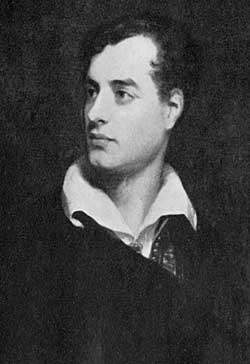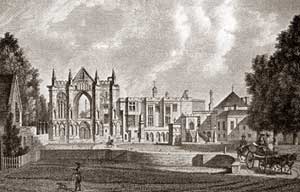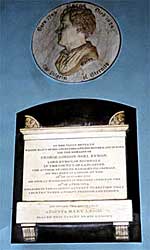

6th Lord Byron (1788-1824) by Thomas Phillips, painted in 1813.
George Gordon Byron (1788-1824), sixth Baron Byron of Rochdale in the English peerage, was one of England’s greatest romantic poets, and for some years the owner of Newstead Abbey. Born in London on 22 January 1788, the son of John Byron (1756-1811) and his second wife Catherine, nee Gordon (1765-1811), and christened at Marylebone parish church, he was subsequently brought up in Aberdeen by his mother following the death of his father in 1791.
In 1798, on the death of his great uncle, William, 5th Lord Byron, he inherited the title and also the family estates in Nottinghamshire and Lancashire. The Nottinghamshire estates, centred on Newstead Abbey, were mainly in Hucknall, Bulwell and Papplewick.
Byron and his mother moved to Newstead in 1798. As the house was in poor condition, Byron lived briefly in Nottingham and then went to Dr Glennie’s school in Dulwich before moving on to Harrow in 1801, and in 1805 going up to Trinity College, Cambridge.
In 1803 Mrs Byron took a lease of Burgage Manor in Southwell, described at the time as "a handsome new house and very pleasantly situated." It was built about 1780, and overlooked Burgage Green. She paid 35 guineas (£36.75) rent, and lived in the house until 1808. Byron visited her there for the first time in July 1803, and paid several further visits to 1808. It was really his home in those years, but he complained that Southwell was full of "old parsons and old Maids." Byron made friends in the town, notably with Elizabeth Pigot. Elizabeth was five years older than Byron and lived with her family in a house just across the Green from Burgage Manor. During school vacations in Southwell from Harrow, and then from Cambridge, Byron was a regular visitor to the Pigot household. The longest period he spent in Southwell was the year from summer 1806 to summer 1807, and it was here that he completed work on his first book of poems, Fugitive Pieces, privately published in November 1806, and two subsequent collections Poems on Various Occasions, and Hours of Idleness. He also participated in amateur dramatics. Mrs Byron gave up the lease and returned to Newstead in 1808, where she died in 1811.

Newstead Abbey in the 18th century.
After graduating from Cambridge in 1808 he settled at Newstead Abbey where he undertook (but did not pay for!) a great many renovations. He returned to London in time for his 21st birthday on 22 January 1809, at which point he inherited the family estates in his own right.
On 13 March 1809 he took his seat in the House of Lords and attended on a number of occasions before in July departing with John Cam Hobhouse on a tour of the southern Mediterranean, taking in Portgual, Malta, Sicily, Greece, Albania.
Byron returned to England in July 1811 but set out for Newstead too late to be with his mother, who died on 1 August. Thereafter he spent some time on estate business, including a brief visit to his Lancashire properties at Rochdale, but then returned to London before visiting Newstead again for a visit over Christmas.
Byron returned to London to take up his political career in the House of Lords, and made his maiden speech on the framework knitters' bill, on 27 February 1812. He continued to attend the House, aligning himself with the opposition Foxite-Whigs, but his interest waned after the publication in March 1812 of Childe Harold’s Pilgrimage, at which point he became the talk of literary London. His friend Thomas Moore was later to report Byron as saying "I awoke one morning and found myself famous." He subsequently had a passionate affair with Lady Caroline Lamb, who famously claimed that Byron was "mad, bad and dangerous to know."
With his new status as a major literary figure, Byron decided to liquidate his debts by selling his Newstead Abbey estate, which went on to the market in August 1814. It did not sell, but was 'bought' privately by Thomas Claughton, a Lancashire attorney, in a deal which subsequently fell through in August 1814 at which point Byron visited the house again, with his half-sister Augusta and her children.
In September 1814 he proposed (by post) to Annabella Milbanke, who he married on 2 January 1815. They had one daughter, Ada. Byron never took Annabella to Newstead.
Byron offered Newstead for sale again in 1815 without success.
Byron’s marriage broke up early in 1816, and after rumours spread about his private life, particularly his relationship with Augusta, he moved abroad in April 1816, first to Geneva, and then on to Italy where he lived until 1823, at various places including Venice and Genoa.

Byron's monument in Hucknall church.
Newstead was finally sold in 1817 to Colonel Thomas Wildman, although the transaction took until 1819 to complete, largely because of the time taken for papers to go backwards and forwards to Italy for Byron’s signature.
Byron moved in 1823 from Italy to Greece, and died at Missolonghi in April 1824.
Byron had no further links to Nottinghamshire until his death. His body was brought back to England for burial, but as a result of his by then notorious reputation his friends were refused permission to have him buried in Westminster Abbey. Instead he was buried at St Mary’s, Hucknall, in the Byron family tomb.
Byron’s interest in Newstead is discussed in a separate essay by the literary scholar, Dr Peter Cochrane.